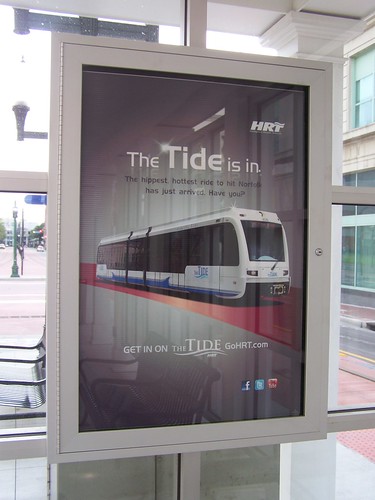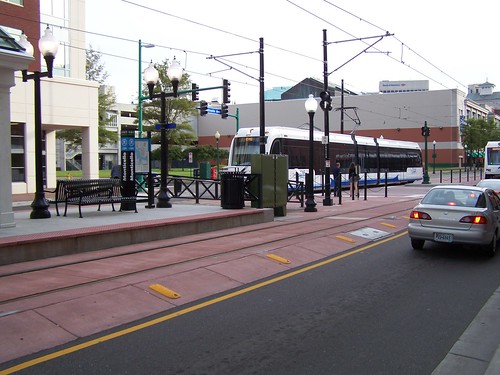One reason to focus new fixed rail transit on those places where it can be wildly successful: it doesn't give ammunition to critics
 Norfolk opened up a light rail system in 2010, and it gets about 4,400 daily riders, which is pretty pathetic.
Norfolk opened up a light rail system in 2010, and it gets about 4,400 daily riders, which is pretty pathetic. It's difficult for fixed rail transit to be successful in Hampton Roads because the population is spread widely and without service to military bases, it's difficult to drive ridership upwards.
The original idea was for the system to connect Norfolk and Virginia Beach, but VB opted out from the original program, and there was the idea that once other parts of the metropolitan area experienced the system, they would work to extend the system.
That's what's happening now. A couple years ago, Virginia Beach passed a referendum supporting light rail.
Earlier in the week, transit opponent Randal O'Toole gave a lightly attended talk to an anti-transit group in Virginia Beach, as the city studies expanding and joining the Norfolk-based light rail system--of course, part of the reason ridership is low is because Virginia Beach isn't part of the system.
 But it's also low because it's a single line, not a transit network. And that might doom the system to low ridership forever.
But it's also low because it's a single line, not a transit network. And that might doom the system to low ridership forever.O'Toole's presentation is online and the Norfolk Virginian-Pilot had a story on the talk, "Light rail or "lie rail"? Foe tears into Tide at Beach talk."
While the reasons or "lies" do have more than a grain of truth as it relates to Greater Norfolk, they aren't true in places with greater population, residential density, and a tight network of activity centers.
The lies according to Randal O'Toole:
-- Lie #1: “Light Rail Is High-Capacity Transit”
-- Lie #2: “VA Beach Needs High-Capacity Transit”
-- Lie #3: “It Will ‘Only’ Cost $327 Million”
-- Lie #4: “Light Rail Attracts New Riders”
-- Lie #5: “Light Rail Will Reduce Congestion”
-- Lie #6: “Light Rail Will Save Energy”
-- Lie #7: “Light Rail Stimulates Development” (I do have to comment that his proof of this argument with regard to Portland is 18 years old...)
-- Lie #8: “Light Rail Is Good for Transit Riders”
-- Lie #9: Light Rail Is Cost-Effective
-- Lie #10: “Light Rail Is Modern Transportation”
He does say that driverless cars will make transit obsolete...
And with regard to there being a better payoff for investing in transit in places where it has a greater likelihood of being successful, the new Green Line in St. Paul, Minnesota, has more than 37,000 daily riders after less than 5 months in service. See "Green Line monthly ridership tops 1 million" from the St. Paul Pioneer-Press.
From the article:
Last month, 1,063,512 rides were taken on the Green Line, pushing average weekday ridership in September to 37,178, according to Metro Transit. That average is 35 percent higher than the ridership projection for 2015.Although because transit ridership went up less than 3% overall on a percentage basis, likely a goodly number of these riders have diverted from buses.
Labels: car culture and automobility, fixed rail transit service, public finance and spending, transit marketing, transportation planning



2 Comments:
On this note, I figured you would dig this digital magazine on railroad bridges: http://issuu.com/railwaytrackstructures/docs/rts_1114_reduced
Thanks!, although personally, I hate the Issuu platform, because you can't download...
Post a Comment
<< Home